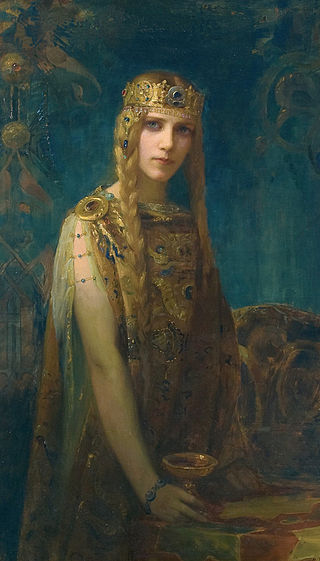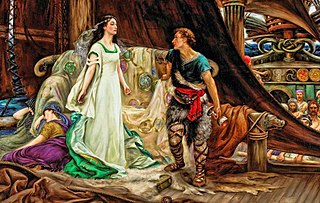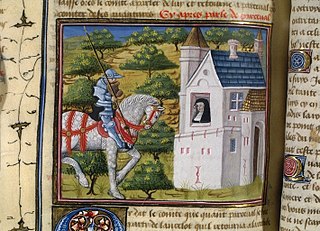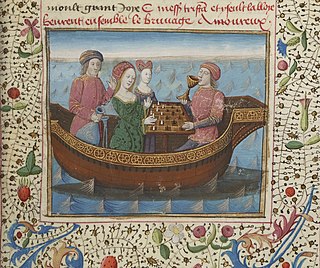Related Research Articles

The Round Table is King Arthur's famed table in the Arthurian legend, around which he and his knights congregate. As its name suggests, it has no head, implying that everyone who sits there has equal status, unlike conventional rectangular tables where participants order themselves according to rank. The table was first described in 1155 by Wace, who relied on previous depictions of Arthur's fabulous retinue. The symbolism of the Round Table developed over time; by the close of the 12th century it had come to represent the chivalric order associated with Arthur's court, the Knights of the Round Table.

Tristan, also known as Tristram, Tristyn or Tristain and similar names, is the hero of the legend of Tristan and Iseult. In the legend, he is tasked with escorting the Irish princess Iseult to wed Tristan's uncle, King Mark of Cornwall. Tristan and Iseult accidentally drink a love potion during the journey and fall in love, beginning an adulterous relationship that eventually leads to Tristan's banishment and death. The character's first recorded appearance is in retellings of British mythology from the 12th century by Thomas of Britain and Gottfried von Strassburg, and later in the Prose Tristan. He is featured in Arthurian legends, including the seminal text Le Morte d'Arthur, as a skilled knight and a friend of Lancelot.

Gottfried von Strassburg is the author of the Middle High German courtly romance Tristan, an adaptation of the 12th-century Tristan and Iseult legend. Gottfried's work is regarded, alongside the Nibelungenlied and Wolfram von Eschenbach's Parzival, as one of the great narrative masterpieces of the German Middle Ages. He is probably also the composer of a small number of surviving lyrics. His work became a source of inspiration for Richard Wagner's opera Tristan und Isolde (1865).

Iseult, alternatively Isolde and other spellings, is the name of several characters in the legend of Tristan and Iseult. The most prominent is Iseult of Ireland, the wife of Mark of Cornwall and the lover of Tristan. Her mother, the queen of Ireland, is also named Iseult. The third is Iseult of the White Hands, the daughter of Hoel of Brittany and the sister of Kahedin.
Rustichello da Pisa, also known as Rusticiano, was an Italian romance writer in Franco-Italian language. He is best known for co-writing Marco Polo's autobiography, The Travels of Marco Polo, while they were in prison together in Genoa. Earlier, he wrote the Roman de Roi Artus, also known as the Compilation, the earliest known Arthurian romance by an Italian author.

Lohengrin is a character in German Arthurian literature. The son of Parzival (Percival), he is a knight of the Holy Grail sent in a boat pulled by swans to rescue a maiden who can never ask his identity. His story, which first appears in Wolfram von Eschenbach's Parzival, is a version of the Knight of the Swan legend known from a variety of medieval sources. Wolfram's story was expanded in two later romances. Richard Wagner's opera Lohengrin of 1848 is based upon the legend.

Tristan and Iseult, also known as Tristan and Isolde and other names, is a medieval chivalric romance told in numerous variations since the 12th century. Based on a Celtic legend and possibly other sources, the tale is a tragedy about the illicit love between the Cornish knight Tristan and the Irish princess Iseult. It depicts Tristan's mission to escort Iseult from Ireland to marry his uncle, King Mark of Cornwall. On the journey, Tristan and Iseult ingest a love potion, instigating a forbidden love affair between them.

Perceval, the Story of the Grail is the unfinished fifth verse romance by Chrétien de Troyes, written by him in Old French in the late 12th century. Later authors added 54,000 more lines to the original 9,000 in what are known collectively as the Four Continuations, as well as other related texts. Perceval is the earliest recorded account of what was to become the Quest for the Holy Grail but describes only a golden grail in the central scene, does not call it "holy" and treats a lance, appearing at the same time, as equally significant. Besides the eponymous tale of the grail and the young knight Perceval, the poem and its continuations also tell of the adventures of Gawain and some other knights of King Arthur.
Thomas of Britain was a poet of the 12th century. He is known for his Old French poem Tristan, a version of the Tristan and Iseult legend that exists only in eight fragments, amounting to around 3,300 lines of verse, mostly from the latter part of the story. It is calculated that this represents about one sixth of the original.
Der Stricker is the pseudonym of a 13th-century Middle High German itinerant poet whose real name has been lost to history. His name, which means "The Knitter," may indicate he was a commoner; he was likely from Franconia but later worked in Austria. His works evince a knowledge of German literature and practical theology, and include both adaptations and works with no known sources.
Daniel von dem blühenden Tal is an Arthurian romance composed around 1220 by the Middle High German poet Der Stricker, who claimed he had received the story from a French troubadour. It tells how Sir Daniel, heir to the kingdom of Blumenthal, becomes a Knight of the Round Table and engages in fantastic adventures to defend King Arthur's land from an enemy ruler.

The Prose Tristan is an adaptation of the Tristan and Iseult story into a long prose romance, and the first to tie the subject entirely into the arc of the Arthurian legend. It was also the first major Arthurian prose cycle commenced after the widely popular Lancelot-Grail, which influenced especially the later portions of the Prose Tristan.
Tristan is a Knight of the Round Table in Arthurian legend.
Perlesvaus, also called Li Hauz Livres du Graal, is an Old French Arthurian romance dating to the first decade of the 13th century. It purports to be a continuation of Chrétien de Troyes' unfinished Perceval, the Story of the Grail, but it has been called the least canonical Arthurian tale because of its striking differences from other versions.
Brangaine is the handmaid and confidante of Iseult of Ireland in the Arthurian legend of Tristan and Iseult. She appears in most versions of the story.
"Chevrefoil" is a Breton lai by the medieval poet Marie de France. The eleventh poem in the collection called The Lais of Marie de France, its subject is an episode from the romance of Tristan and Iseult. The title means "honeysuckle," a symbol of love in the poem. "Chevrefoil" consists of 118 lines and survives in two manuscripts, Harley 978 or MS H, which contains all the Lais, and in Bibliothèque Nationale, nouv. acq. fr. 1104, or MS S.
Der Pleier is the pen name of a 13th-century German poet whose real name is unknown. Three of his works survive, all Middle High German romances on Arthurian subjects: Garel, Tandareis und Flordibel, and Meleranz. Little else is known of him, but he was an important figure in the revival of Arthurian literature in Germany in the mid-13th century, after decades of declining interest in the subject.
Brother Robert was a cleric working in Norway who adapted several French literary works into Old Norse during the reign of King Haakon IV of Norway (1217–1263). The most important of these, Tristrams saga ok Ísöndar, based on Thomas of Britain's Tristan, is notable as the only example of Thomas' "courtly branch" of the Tristan and Iseult legend that has survived in its entirety. It was the earliest Scandinavian version of the story, and is thought to be the first Norwegian adaptation of an Old French work. Its success may have inspired the spate of translations during King Haakon's reign.
Palamedes is a 13th-century Old French Arthurian prose chivalric romance. Named for King Arthur's knight Palamedes, it is set in the time before the rise of Arthur, and relates the exploits of the parents of various Arthurian heroes. The work was very popular, but now exists largely in fragmentary form.
Béroul was a Norman or Breton poet of the mid-to-late 12th century. He is usually credited with the authorship of Tristran, a Norman language version of the legend of Tristan and Iseult, of which just under 4500 verses survive in a manuscript of the 13th century. His name is known only from two references in the text of the poem.
References
- Bédier, Joseph; Belloc, Hilaire (translator) (1994). The Romance of Tristan and Iseult. New York: Vintage Books. ISBN 0-679-75016-9.
- Béroul; Fedrick, Alan S. (translator) (1978). The Romance of Tristan: The Tale of Tristan's Madness. New York: Penguin. ISBN 0-14-044230-8.
- Lacy, Norris J. (Ed.) (1991). The New Arthurian Encyclopedia. New York: Garland. ISBN 0-8240-4377-4.
- Lacy, Norris J.; Ashe, Geoffrey; and Mancroff, Debra N. (1997). The Arthurian Handbook. New York: Garland. ISBN 0-8153-2081-7.